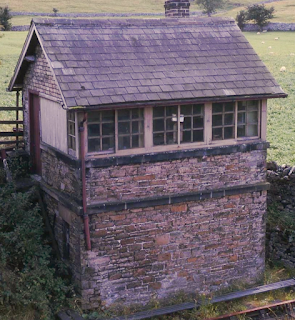As remarked upon previously, the ex-Pesspool Junction frame was missing a couple of key components: the longitudinal tie bars that fasten to the vertical stanchions and support the quadrants at floor level.
 |
| The steel bar, cleaned up and ready for initial marking out. |
We sourced some suitable steel bar, in long enough lengths, and brought it up to KSE a few weeks ago. Quite a lot of careful measuring and recording was required, as not all the lever quadrants are the same! Those that sit above the stanchions have their holes offset slightly to the left of the frame (by 3/8"), whereas the others are all nicely spaced.
 |
| Some of the variations in the hole spacings can be seen here in the various quadrants |
Another key difference we only spotted as we started to mark out, was that the quadrants above the inner pair of stanchions also had an offset towards the longitudinal centreline of the frame! Fortunately there was time to rectify this before any drilling took place! The discrepancy can be seen here:
First up, we marked out the position of the quadrants, and numbered them, so as to throw up any issues with the 'proper' marking out to follow.
The hole centres were marked using a scribe, then centre punched. A mag drill was set up, using the punchings for alignment, and then it was full speed ahead with drilling holes. Lots of holes. 92, to be precise!
 |
| Scribing the centres |
 |
| Punching the centres |
With the holes marked out, you might hope it would be plain sailing with the drilling. But with 92 holes to cut through 3/4" steel, this was not the case!
Drilling was definitely easiest with 2 people, a mag drill (with a centre) and some cutting fluid. Fortunately, setting up the mag drill WAS straightforward, aligning the centre punched marks with the drill centre (which is sprung, so as to eject the slug once the drill goes through).
Then it was a case of double-checking and applying the correct force to the drill, to wind it through, whilst the second person kept an eye on the process as well as 'fed' it with lubricant.
So, 92 holes drilled successfully, with only 1 that didn't quite seem to centre: a little bit of attention from a file will cure any issues there when we come to fit it all together.

As I mentioned at the beginning, the work has concentrated on preparing the longitudinal tie bars for the frame. Once they were drilled, attention turned to the lever quadrants that bolt on top of them, and provide the 'floor' part of the frame that you see upstairs!
 |
| Offering up a few of the quadrants as a test to the newly-drilled tiebars |
There are 23 of these castings, numbered for the lever that sits to the right of the casting, with No.23 providing the top end (numerically) of the frame with no lever associated.
 |
| The undersides of the quadrants, cleaned up ready for painting |
We cleaned each of the quadrants down with wire brushes, applied primer and have then used grey enamel paint on the undersides, to match all the 'downstairs' / locking room components.
 |
| Red oxide primer all round: the tops seen here |
 |
The extent of the grey is apparent on the undersides.
Mating faces will be cleaned off prior to fitting, as required |
The sides of the quadrants, which can (just about) be seen from above, are painted black. This had to be done now, as they will be almost impossible to paint once in situ! The tops, however, remain in primer until they are in their final position, as there will be a great risk of damage to any paint finish until everything is installed fully.
 |
| One set of sides in black |
 |
| ...the other set of sides, also in black |
The next step with the frame will be the installation itself, within the box. Initially, we will leave the levers themselves out, so as to allow easy access upstairs for finishing and painting works. The rest of the floor will tie to the frame as well, so we don't want too many additional obstacles when resolving this!
















Comments
Post a Comment